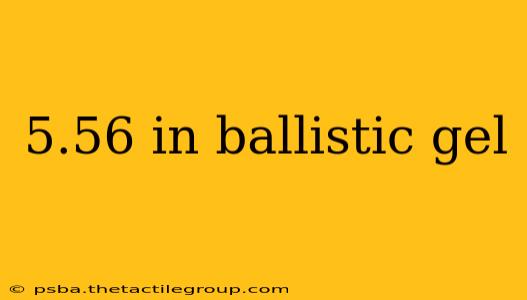The 5.56x45mm NATO cartridge, a ubiquitous round in military and civilian applications, has been the subject of extensive testing and analysis. Understanding its performance in ballistic gel, a common medium used to simulate human tissue, is crucial for anyone interested in firearms, ballistics, or self-defense. This deep dive will explore the complex interaction between the 5.56mm round and ballistic gel, examining factors influencing its terminal effects and dispelling common myths.
Factors Influencing 5.56mm Performance in Ballistic Gel
Numerous variables impact the performance of a 5.56mm round in ballistic gel, affecting its penetration depth, wound cavity creation, and overall effectiveness. These include:
1. Ammunition Type:
-
Full Metal Jacket (FMJ): FMJ rounds are designed for penetration and have a relatively small temporary wound cavity. In ballistic gel, they typically exhibit deeper penetration compared to other projectile types. However, their limited expansion results in a narrower wound channel.
-
Hollow Point (HP): HP rounds are designed to expand upon impact, creating a larger temporary wound cavity. This expansion often leads to reduced penetration depth compared to FMJ rounds, but a more significant tissue disruption within the impacted area. Variations in HP design (e.g., JHP, JSP) further influence their performance.
-
Soft Point (SP): Soft point rounds offer a balance between penetration and expansion, presenting an intermediary performance characteristic between FMJ and HP rounds.
2. Projectile Weight:
Heavier projectiles generally penetrate deeper but may exhibit less expansion. Conversely, lighter projectiles often expand more readily but penetrate less. This weight-expansion trade-off is a critical aspect of terminal ballistics.
3. Velocity:
Higher velocity rounds deliver more kinetic energy upon impact, leading to increased penetration and temporary cavity size. However, excessive velocity can sometimes lead to over-penetration, reducing overall effectiveness within the target.
4. Gel Density:
The density of the ballistic gel itself impacts penetration depth. Variations in gel formulation can significantly affect the results. Consistency in gel preparation and testing methodologies is paramount for reliable comparisons.
5. Barrel Length:
Longer barrels generally result in higher projectile velocities, influencing penetration and expansion characteristics within the gel.
Interpreting Ballistic Gel Tests: Beyond Simple Penetration Depth
While penetration depth is a frequently cited metric, it doesn't provide a complete picture of a round's effectiveness. Factors such as permanent cavity size (the actual tissue damage) and temporary cavity size (the initial expanding cavity) are equally crucial for understanding the overall terminal effect. Modern ballistic gel testing frequently incorporates high-speed video analysis to provide a detailed visualization of these factors.
Debunking Myths and Misconceptions
Several misconceptions surround 5.56mm performance. Claims regarding "tumbling" or uncontrolled yaw are often debated. While some rounds might exhibit yaw or tumbling in certain conditions, it's not a universally consistent phenomenon. Proper testing protocols are crucial to accurately assess and understand such behaviors.
Conclusion: A Complex Interaction
The behavior of 5.56mm rounds in ballistic gel is a complex interplay of numerous factors. Understanding these factors is essential for responsible firearms ownership, informed ammunition selection, and a comprehensive understanding of terminal ballistics. It's crucial to approach information on this topic with a critical eye, recognizing the importance of controlled testing and avoiding generalizations based on limited or anecdotal evidence. Further research and analysis from reputable sources are encouraged to develop a well-rounded understanding of this fascinating subject.

